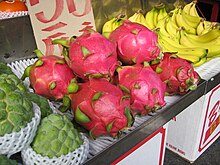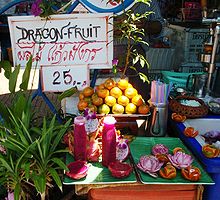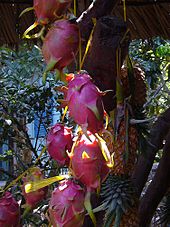| Revision as of 06:07, 29 December 2024 editVishalchandak005 (talk | contribs)86 editsmNo edit summaryTags: Reverted Visual edit← Previous edit | Revision as of 06:17, 29 December 2024 edit undoIiii I I I (talk | contribs)Extended confirmed users, Pending changes reviewers, Rollbackers4,600 edits Reverted 1 edit by Vishalchandak005 (talk)Tags: Twinkle UndoNext edit → | ||
| Line 24: | Line 24: | ||
| '']'' fruit (sour pitayas) are a variety that is commonly eaten in the arid regions of the Americas. They are more sour and refreshing, with juicier flesh and a stronger taste. | '']'' fruit (sour pitayas) are a variety that is commonly eaten in the arid regions of the Americas. They are more sour and refreshing, with juicier flesh and a stronger taste. | ||
| The sour pitaya or ''pitaya |
The sour pitaya or ''pitaya agria'' ('']'') in the ] has been an important food source for ]. The ] of northwestern Mexico still harvest the fruit, and call the plant ''ziix is ccapxl'' "thing whose fruit is sour". | ||
| The fruit of related species, such as '']'' and the dagger cactus or ''pitaya de mayo'' ('']''),<ref name="EoFN"/>{{rp|223–225}} are also locally important foods. The fruit of the organ pipe cactus ('']'', called ''ool'' by the Seris) is the ''pitaya dulce'' "sweet pitaya". | The fruit of related species, such as '']'' and the dagger cactus or ''pitaya de mayo'' ('']''),<ref name="EoFN"/>{{rp|223–225}} are also locally important foods. The fruit of the organ pipe cactus ('']'', called ''ool'' by the Seris) is the ''pitaya dulce'' "sweet pitaya". | ||
| Line 94: | Line 94: | ||
| }} | }} | ||
| ==Nutrients== | ==Nutrients== | ||
| The ] published their analysis of the nutritional contents of raw Pitaya in 2022.<ref>{{cite web | url=https://fdc.nal.usda.gov/fdc-app.html#/food-details/2344729/nutrients | title=FoodData Central }}</ref> The majority of the fruit by weight is water (87g out of 100g). One serving of {{convert|100|g|oz|abbr=off|adj=on|frac=2}} provides {{convert|57|kcal|kJ|order=flip|abbr=off}} of food energy. | The ] published their analysis of the nutritional contents of raw Pitaya in 2022.<ref>{{cite web | url=https://fdc.nal.usda.gov/fdc-app.html#/food-details/2344729/nutrients | title=FoodData Central }}</ref> The majority of the fruit by weight is water (87g out of 100g). One serving of {{convert|100|g|oz|abbr=off|adj=on|frac=2}} provides {{convert|57|kcal|kJ|order=flip|abbr=off}} of food energy. | ||
| The USDA also reports one limited ] entry from a manufacturer of a ]ed product, showing that a {{convert|100|g|oz|abbr=off|adj=on|frac=2}} reference serving of ''dried'' pitaya provides {{convert|264|kcal|kJ|order=flip|abbr=off}} of ], 82% ]s, 4% ], and 11% of the ] each for ] and ]<ref>{{cite web | url=https://fdc.nal.usda.gov/fdc-app.html#/food-details/411576/nutrients | title=FoodData Central }}</ref>.{{dubious|date=November 2019}} | The USDA also reports one limited ] entry from a manufacturer of a ]ed product, showing that a {{convert|100|g|oz|abbr=off|adj=on|frac=2}} reference serving of ''dried'' pitaya provides {{convert|264|kcal|kJ|order=flip|abbr=off}} of ], 82% ]s, 4% ], and 11% of the ] each for ] and ]<ref>{{cite web | url=https://fdc.nal.usda.gov/fdc-app.html#/food-details/411576/nutrients | title=FoodData Central }}</ref>.{{dubious|date=November 2019}} | ||
Revision as of 06:17, 29 December 2024
Fruit of several cactus species For the city in Thailand, see Pattaya. For the Thai weightlifter, see Pitaya Tibnoke.


A pitaya (/pɪˈtaɪ.ə/) or pitahaya (/ˌpɪtəˈhaɪ.ə/) is the fruit of several cactus species indigenous to the region of southern Mexico and along the Pacific coasts of Guatemala, Costa Rica, and El Salvador. Pitaya is cultivated in East Asia, South Asia, Southeast Asia, the United States, the Caribbean, Australia, Brazil, and throughout tropical and subtropical regions of the world.
Pitaya usually refers to fruit of the genus Stenocereus, while pitahaya or dragon fruit refers to fruit of the genus Selenicereus (formerly Hylocereus), both in the family Cactaceae. The common name in English – dragon fruit – derives from the leather-like skin and scaly spikes on the fruit exterior. Depending on the variety, pitaya fruits may have sweet- or sour-tasting flesh that can be red, white, or yellow in color.
Vernacular names
These fruits are commonly known in English as "dragon fruit", a name used since 1963, apparently resulting from the leather-like skin and prominent scaly spikes on the fruit exterior. The fruit is often designated as "Vietnamese dragon fruit" as Vietnam is the lead exporter. The fruit may also be known as a strawberry pear.
The names pitahaya and pitaya derive from Mexico, and pitaya roja in Central America and northern South America, possibly relating to pitahaya for names of tall cacti species with flowering fruit.
Geography

Pitaya or dragon fruit is native to the region of southern Mexico and along the Pacific coasts of Guatemala, Costa Rica, and El Salvador. The dragon fruit is cultivated in East Asia, South Asia, Southeast Asia, the United States, the Caribbean, Australia, and throughout tropical and subtropical regions of the world.
Varieties
| This section needs additional citations for verification. Please help improve this article by adding citations to reliable sources in this section. Unsourced material may be challenged and removed. (September 2022) (Learn how and when to remove this message) |
Stenocereus
Stenocereus fruit (sour pitayas) are a variety that is commonly eaten in the arid regions of the Americas. They are more sour and refreshing, with juicier flesh and a stronger taste.
The sour pitaya or pitaya agria (S. gummosus) in the Sonoran Desert has been an important food source for indigenous peoples of the Americas. The Seri people of northwestern Mexico still harvest the fruit, and call the plant ziix is ccapxl "thing whose fruit is sour".
The fruit of related species, such as S. queretaroensis and the dagger cactus or pitaya de mayo (S. griseus), are also locally important foods. The fruit of the organ pipe cactus (S. thurberi, called ool by the Seris) is the pitaya dulce "sweet pitaya".
Dragon fruit, Selenicereus

Sweet pitayas come in three types, all with leathery, slightly leafy skin:
- Selenicereus undatus (Pitaya blanca or white-fleshed pitaya, also known as Hylocereus undatus) has pink-skinned fruit with white flesh. This is the most commonly seen "dragon fruit".
- Selenicereus costaricensis (Pitaya roja or red-fleshed pitaya, also known as Hylocereus costaricensis, and possibly incorrectly as Hylocereus polyrhizus) has red-skinned fruit with red flesh.
- Selenicereus megalanthus (Pitaya amarilla or yellow pitaya, also known as Hylocereus megalanthus) has yellow-skinned fruit with white flesh.
The fruit normally weighs from 150 to 600 grams (5+1⁄2 to 21 oz); some may reach 1 kg (2 lb 3 oz). Early imports from Colombia to Australia were designated "Hylocereus ocampensis" (or "Cereus repandus", the red fruit) and "Cereus triangularis" (supposedly, the yellow fruit or the three-sided cross-section of the stem).
Cultivation


After a thorough cleaning of the seeds from the pulp of the fruit, the seeds may be stored when dried. The ideal fruit is unblemished and overripe.
Seeds grow well in a compost or potting soil mix – even as a potted indoor plant. Pitaya cacti usually germinate after between 11 and 14 days after shallow planting. As they are cacti, overwatering is a concern for home growers. As their growth continues, these climbing plants will find something to climb on, which can involve putting aerial roots down from the branches in addition to the basal roots. Once the plant reaches a mature 4.5 kilograms (10 pounds) in weight, the plant may flower.
Commercial plantings can be done at high density with between 1,100 and 1,350 per hectare (445 and 546/acre). Plants can take up to 60 months/260 weeks to come into full commercial production, at which stage yields of 20 to 30 metric tons (22 to 33 short tons) can be expected.
Pitaya flowers bloom overnight and usually wilt by the evening. They rely on nocturnal pollinators such as bats or moths for fertilization. Self-fertilization will not produce fruit in some species and while crossbreeding has resulted in several "self-fertile" varieties, cross-pollinating with a second, genetically distinct plant of the same species generally increases fruit set and quality. This limits the capability of home growers to produce the fruit. However, the plants can flower between three and six times per year depending on growing conditions. Like other cacti, if a healthy piece of the stem is broken off, it may take root in the soil and become its own plant.
The plants can endure temperatures up to 40 °C (104 °F) and short periods of frost but will not survive long exposure to freezing temperatures. The cacti thrive most in USDA zones 10–11 but may survive outdoors in zone 9a or 9b.
Selenicereus has adapted to live in dry tropical climates with a moderate amount of rain. In numerous regions, it has escaped cultivation to become a weed and is classified as an invasive weed in some countries.
Pests and diseases
Stems and fruits are susceptible to several diseases caused by fungi, bacteria, a nematode, and a virus. Overwatering or excessive rainfall can cause the flowers to drop and fruit to rot. The bacterium Xanthomonas campestris causes the stems to rot. Dothiorella fungi can cause brown spots on the fruit. Other fungi known to infect pitaya include Botryosphaeria dothidea, Colletotrichum gloeosporioides and Bipolaris cactivora.
Uses
Culinary
The fruit's texture is sometimes likened to that of the kiwifruit because of its black, crunchy seeds. The seed oil contains the fatty acids linoleic acid and linolenic acid. Dragon fruit is used to flavor and color juices and alcoholic beverages, such as "Dragon's Blood Punch" and the "Dragotini". The flowers can be eaten or steeped as tea.
The red and purple colors of some Selenicereus fruits are due to betacyanins, a family of pigments that includes betanin, the same substance that gives beets, Swiss chard, and amaranth their red color.
| Nutritional value per 100 g (3.5 oz) | |||||||||||||||||||||||||||||||||||||
|---|---|---|---|---|---|---|---|---|---|---|---|---|---|---|---|---|---|---|---|---|---|---|---|---|---|---|---|---|---|---|---|---|---|---|---|---|---|
| Energy | 240 kJ (57 kcal) | ||||||||||||||||||||||||||||||||||||
| Carbohydrates | 15.2 g | ||||||||||||||||||||||||||||||||||||
| Sugars | 9.75 g | ||||||||||||||||||||||||||||||||||||
| Dietary fiber | 3.1 g | ||||||||||||||||||||||||||||||||||||
| Fat | 0.14 g | ||||||||||||||||||||||||||||||||||||
| Protein | 0.36 g | ||||||||||||||||||||||||||||||||||||
| |||||||||||||||||||||||||||||||||||||
| Other constituents | Quantity | ||||||||||||||||||||||||||||||||||||
| Water | 84 g | ||||||||||||||||||||||||||||||||||||
Link to USDA Database entry | |||||||||||||||||||||||||||||||||||||
| Percentages estimated using US recommendations for adults, except for potassium, which is estimated based on expert recommendation from the National Academies. | |||||||||||||||||||||||||||||||||||||
Nutrients
The USDA FoodData Central database published their analysis of the nutritional contents of raw Pitaya in 2022. The majority of the fruit by weight is water (87g out of 100g). One serving of 100-gram (3+1⁄2-ounce) provides 240 kilojoules (57 kilocalories) of food energy.
The USDA also reports one limited product label entry from a manufacturer of a branded product, showing that a 100-gram (3+1⁄2-ounce) reference serving of dried pitaya provides 1,100 kilojoules (264 kilocalories) of food energy, 82% carbohydrates, 4% protein, and 11% of the Daily Value each for vitamin C and calcium.
Seed oils
The fatty acid compositions of the seed oils of Selenicereus costaricensis, syn. Hylocereus costaricensis (red-fleshed pitaya) and Selenicereus undatus, syn. Hylocereus undatus (white-fleshed pitaya) were similar: myristic acid (negligible), palmitic acid (17%), stearic acid (5%), palmitoleic acid (about 1%), oleic acid (22%), cis-vaccenic acid (3%), linoleic acid (50%), and α-linolenic acid (1%).
Gallery
-
 Pitaya "tree"
Pitaya "tree"
-
Plantation in Naozhou Island
-
 Nocturnal flowering
Nocturnal flowering
-
 Yellow S. megalanthus
Yellow S. megalanthus
-
 Red S. costaricensis
Red S. costaricensis
-
 Jus buah naga, purple pitaya juice, Indonesia
Jus buah naga, purple pitaya juice, Indonesia
-
 Red, yellow and white fruits
Red, yellow and white fruits
-
Dress for a folk dance called Flor de Pitahaya "Pitahaya Flower" from Baja California Sur displayed at the Museo de Arte Popular in Mexico City
-
 Dissected pitaya
Dissected pitaya
See also
- List of culinary fruits
- Opuntia – prickly pear cacti with edible "cactus figs" or tunas fruit
References
- ^ "Hylocereus undatus (dragon fruit)". Invasive Species Compendium. CABI (Centre for Agriculture and Bioscience International). 3 January 2018. Retrieved 19 April 2018.
- ^ Morton, J.F. (1987). Fruits of warm climates. West Lafayette, Indiana, USA: Center for New Crops & Plant Products, Department of Horticulture and Landscape Architecture, Purdue University. pp. 347–348. Archived from the original on 5 May 2016. Retrieved 8 April 2016.
- ^ Janick, Jules; Paull, Robert E., eds. (2008). "C". The Encyclopedia of Fruit and Nuts. Cambridge, United Kingdom: CABI (Centre for Agriculture and Bioscience International). pp. 215–216, 222–226. ISBN 978-0-85199-638-7.
- "Dragon fruit". Merriam-Webster Dictionary. 2019. Retrieved 25 March 2019.
- Menon, Jayant; Roth, Vathana (21 June 2022). Agricultural Trade between China and the Greater Mekong Subregion Countries: A Value Chain Analysis. ISEAS-Yusof Ishak Institute. ISBN 978-981-5011-13-5.
- Mitcham, Elizabeth Jeanne; Tonetto de Freitas, Sérgio (August 2013). "Quality of pitaya fruit (Hylocereus undatus) as influenced by storage temperature and packaging" (PDF). Scientia Agricola. 70 (4): 257–262. doi:10.1590/S0103-90162013000400006. ISSN 0103-9016.
- "Dragon fruit". National Library Board, Singapore Government. 2017. Archived from the original on 21 November 2016. Retrieved 19 March 2017.
- Rojas-Sandoval, J.; Praciak, A. (2022). "Hylocereus undatus (dragon fruit)". Invasive Species Compendium. CABI (Centre for Agriculture and Bioscience International). doi:10.1079/cabicompendium.27317. Retrieved 12 October 2020.
- "Dragon Fruit – Amorentia Sweet Dragon Fruit". Retrieved 5 June 2018.
- Boning, Charles R. (2006). Florida's Best Fruiting Plants: Native and Exotic Trees, Shrubs, and Vines. Sarasota, Florida: Pineapple Press, Inc. p. 185. ISBN 978-1-56164-372-1.
- Setzer, Kenneth (26 July 2014). "Dragon fruit surprisingly easy to grow". Miami Herald. Archived from the original on 20 March 2017. Retrieved 19 March 2017.
- ^ Balendres, M; Bengoa, J (2019). "Diseases of dragon fruit (Hylocereus species): Etiology and current management options". Crop Protection. 126: 104920. Bibcode:2019CrPro.12604920B. doi:10.1016/j.cropro.2019.104920. S2CID 202020863.
- Masyahit, M.; Sijam, K.; Awang, Y.; Ghazali, M. (February 2013). "The Occurrence of Anthracnose Disease Caused by Colletotrichum Gloeosporioides on Dragon Fruit (Hylocereus SPP.) in Peninsular Malaysia" (PDF). Acta Horticulturae (975): 187–195. doi:10.17660/actahortic.2013.975.20. ISSN 0567-7572.
- ^ Ariffin, Abdul Azis; Bakar, Jamilah; Tan, Chin Ping; Rahman, Russly Abdul; Karim, Roselina; Loi, Chia Chun (2008). "Essential fatty acids of pitaya (dragon fruit) seed oil" (PDF). Food Chemistry. 114 (2): 561–64. doi:10.1016/j.foodchem.2008.09.108.
- Small, Ernest (2011). Top 100 Exotic Food Plants. CRC Press. p. 105. ISBN 9781439856888. Archived from the original on 18 November 2017. Retrieved 29 July 2017.
- K, Lim T. (2012). Edible Medicinal and Non-Medicinal Plants: Volume 1, Fruits. Springer Science & Business Media. p. 641. ISBN 9789048186617. Archived from the original on 18 November 2017. Retrieved 29 July 2017.
- O. P. S. Rebecca, A. N. Boyce and S. Chandran (2010), "Pigment identification and antioxidant properties of red dragon fruit (Hylocereus polyrhizus)" African Journal of Biotechnology, volume 9, issue 10, pp. 1450–54.
- C. S. Tang and M. H. Norziah (2007) "Stability of betacyanin pigments from red purple pitaya fruit (Hylocereus polyrhizus): Influence of pH, temperature, metal ions and ascorbic acid" Indonesian Journal of Chemistry, volume 7, issue 3, pp. 327–31.
- United States Food and Drug Administration (2024). "Daily Value on the Nutrition and Supplement Facts Labels". FDA. Archived from the original on 27 March 2024. Retrieved 28 March 2024.
- National Academies of Sciences, Engineering, and Medicine; Health and Medicine Division; Food and Nutrition Board; Committee to Review the Dietary Reference Intakes for Sodium and Potassium (2019). "Chapter 4: Potassium: Dietary Reference Intakes for Adequacy". In Oria, Maria; Harrison, Meghan; Stallings, Virginia A. (eds.). Dietary Reference Intakes for Sodium and Potassium. The National Academies Collection: Reports funded by National Institutes of Health. Washington, DC: National Academies Press (US). pp. 120–121. doi:10.17226/25353. ISBN 978-0-309-48834-1. PMID 30844154. Retrieved 5 December 2024.
- "FoodData Central".
- "FoodData Central".
External links
 Media related to Pitaya at Wikimedia Commons
Media related to Pitaya at Wikimedia Commons